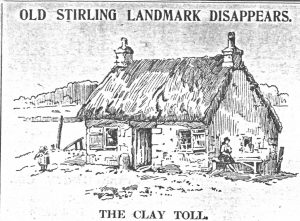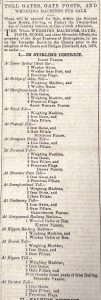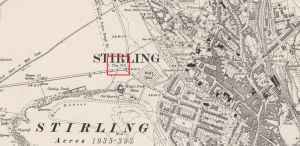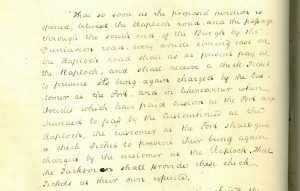If you have been out exploring the ground at the King’s Knot in Stirling, there is a good chance you would have passed the site of an old Stirling landmark: The Clay Toll.
As the name suggests, the Clay Toll was a tollhouse. It operated at the current King’s Knot roundabout. This was the old road junction between Raploch Road and Dumbarton Road. A small plinth at the roundabout marks the site where it used to stand.
During the 19th century, the Clay Toll was a distinctive landmark for local residents. The building was a one storey thatched roof cottage and was seen by residents heading out to the curling ponds west of the building.
The building certainly left an impression on local artists, having been painted by Jane Anne Wright and etched by J. S. Fleming at the turn of 1900.

There is no clear date as to when the building was erected, but it was probably at some point between 1804-1815. Main roads in the area began to appear in 1804 but the first mention of the Clay Toll junction can been seen in the Town Council minutes on 18th November 1815.
They note that the proposed junction situated ‘betwixt Raploch Road, and the passage through the south end of the Burgh by the Dumbarton Road’ was to open soon. A year later on 16th November 1816, the Town Council reported that ‘the junction is now opened’.
Unsurprisingly, tollhouses were often unpopular with local residents. To encourage their use, several tollhouses were also licenced premised.
A story reported by the Stirling Observer notes that on one occasion the Clay Toll was forcefully taken over by Curling Club members! The curlers threw the landlord out the building, locked the door and ‘proceeded to make free with the larder’.
In a turn of events, angry onlookers decided to get their revenge. The Town Clerk and Procurator Fiscal poured water down the chimney whilst others shut the windows. Soot and smoke engulfed the Curling Club members inside!

The Clay Toll operated until tolls were abolished in 1883. After this date, the valuation rolls show that building mainly operated as a house for agricultural workers and labourers.
As the building deteriorated, the Town Council began to consider demolishing the Clay Toll on 12th November 1908. The Works Committee noted a proposal from a Mr Stafford Howard to ‘take down the Clay Toll and throw a piece of ground into the road upon certain conditions’. As the building and its land were owned by The Crown, there was a slight delay in proceeding with the demolition until terms could be agreed. The building, however, was finally demolished at the beginning of May 1909.


